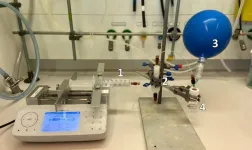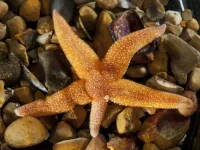(Press-News.org) A meta-analysis of Mediterranean Sea marine species reveals the profound impact of the Messinian Salinity Crisis – a drastic environmental event that resulted in the almost complete evaporation of the Mediterranean Sea roughly 5.5 million years ago. According to the new study’s findings, the event nearly reset the region’s biodiversity. The findings offer novel insights linking tectonic and palaeoceanographic changes to marine biodiversity, highlighting the significant role of salt giants in shaping biogeographic patterns, including those that still influence ecosystems today. The Messinian Salinity Crisis (MSC), occurring between 5.97 and 5.33 million years ago, was a significant environmental event that drastically altered the Mediterranean Sea. Triggered by tectonic activity that closed off the sea’s connection to the Atlantic, the isolation of the Mediterranean led to a repeated cycle of partial or nearly complete desiccation of the basin, resulting in extreme fluctuations in salinity, temperature, and eventually, the accumulation of roughly 1 million cubic kilometers of salt. For hundreds of thousands of years, the mostly dry abyssal plane, which lay 3 to 5 kilometers below sea level, was characterized by high temperatures and a few hypersaline lakes similar to the present-day Dead Sea. However, despite the magnitude of the MSC, its effects on Mediterranean biodiversity at the ecosystem level remain relatively unknown. Leveraging a recently compiled, comprehensive fossil record from the region, which encompassed diverse species from nannoplankton to marine animals, Konstantina Agiadi and colleagues quantified the biodiversity changes associated with the MSC. Agiadi et al. show that the MSC led to significant changes in the Mediterranean’s marine biodiversity, with 66.8% dissimilarity between the species before and after the crisis. Most changes were due to the introduction of new species following the MSC when the Mediterranean reestablished its connection to the Atlantic, rather than the survival of pre-MSC species. Notably, only 86 out of 2006 endemic species survived the event. Moreover, the authors show that the present-day northwest-to-southeast decreasing trend in species richness in the Mediterranean was established after the MSC.
END
Messinian salinity crisis nearly reset Mediterranean biodiversity
Summary author: Walter Beckwith
2024-08-29
ELSE PRESS RELEASES FROM THIS DATE:
Uncovering the secret communication of monkeys: They have names!
2024-08-29
New study from Hebrew University reveals that marmoset monkeys use specific calls, known as "phee-calls," to name each other, a behavior previously known to exist only in humans, dolphins, and elephants. This discovery highlights the complexity of social communication in marmosets and suggests that their ability to vocally label each other may provide valuable insights into the evolution of human language.
LINK to pictures https://drive.google.com/drive/folders/1VjzO-70hk27UVX_IuQ6FTsHgmCgk9PCH?usp=drive_link
Credit for pictures and sound: David Omer Lab
In a groundbreaking discovery, researchers from Hebrew ...
Smart mask monitors breath for signs of health
2024-08-29
Personalized wearable devices that monitor people's health are on the rise. From watches to patches and other types of sensors, these smart devices can monitor heart activity, inflammation levels, and more to help patients better manage their health from their own homes. Now, a new type of wearable device can be added to the list: a high-tech paper mask that monitors one's breath.
Caltech's Wei Gao, professor of medical engineering, and his colleagues have developed a ...
Mechanisms of how morphine relieves pain mapped out
2024-08-29
In a study published in Science, researchers at Karolinska Institutet describe the neural processes behind how morphine relieves pain. This is valuable knowledge because the drug has such serious side effects.
Morphine is a powerful painkiller that belongs to the group of opioids. It blocks signals in the pain pathways and also increases feelings of pleasure.
Morphine acts on several central and peripheral pain pathways in the body, but the neural processes behind the pain relief have not previously been fully understood.
Researchers have now investigated how morphine relieves pain using ...
PFAS-free synthesis of fluorinated pharmaceutical and agrochemical compounds
2024-08-29
Chemists at the University of Amsterdam have developed a method to furnish a range of molecules with a trifluoromethyl group attached to a sulphur, nitrogen or oxygen atom. Their procedure, which has just been published in Science, avoids the use of PFAS reagents. It thus provides an environmentally friendly synthesis route for pharmaceutical and agrochemical compounds that rely on the presence of the trifluoromethyl group.
The straightforward and effective method was developed at the Flow Chemistry group at the Van ‘t Hoff Institute for Molecular Sciences ...
School of Dentistry researchers develop innovative sleep apnea model to find answers to chronic pain
2024-08-29
Scientists at The University of Texas Health Science Center at San Antonio (UT Health San Antonio) School of Dentistry created a first of its kind sleep apnea model for studying chronic pain. A study published July 30 in Science Signaling, explains the mechanism behind persistent pain related to obstructive sleep apnea.
More than 100 million people worldwide are affected by obstructive sleep apnea. This health condition causes a person to stop breathing numerous times while they are sleeping. Reduced sleep time and sleep quality can lead to numerous health problems including chronic pain, which is diagnosed at a much higher rate ...
Plastic surgery patients who use marijuana also have elevated nicotine levels
2024-08-29
August 29, 2024 — Marijuana use is common among patients considering plastic surgery and is associated with elevated nicotine levels on laboratory tests, reports a paper in the September issue of Plastic and Reconstructive Surgery®, the official medical journal of the American Society of Plastic Surgeons (ASPS). The journal is published in the Lippincott portfolio by Wolters Kluwer.
"We found that patients who report marijuana use also have elevated urine nicotine and cotinine levels ...
Machine learning predicts which patients will continue taking opioids after hand surgery
2024-08-29
August 29, 2024 — A machine learning algorithm performs well in predicting the risk of persistent opioid use after hand surgery, reports a study in the August issue of Plastic and Reconstructive Surgery®, the official medical journal of the American Society of Plastic Surgeons (ASPS). The journal is published in the Lippincott portfolio by Wolters Kluwer.
"We found that a machine learning model performs well in identifying hand surgery patients who are more likely to become persistent opioid users," comments ASPS ...
$15.5 million NIH award funds development of national network to include nursing home residents in clinical trials
2024-08-29
INDIANAPOLIS – A team led by research scientists from the Indiana University School of Medicine and Regenstrief Institute has received funding expected to total $15.5 million from the National Institutes of Health’s National Institute on Aging to establish a national network structure to include more nursing home residents in clinical trials.
Even though clinical trials are critical to the development and testing of medical therapies and treatments including drugs and care models, individuals living in nursing homes are rarely included in clinical research studies.
The new five-year award will fund ...
What’s in the microbiome of the foods we eat?
2024-08-29
Microbes are part of the food we eat and can influence our own microbiome, but we know very little about the microbes in our foods. Now, researchers have developed a database of the “food microbiome” by sequencing the metagenomes of 2,533 different foods. They identified 10,899 food-associated microbes, half of which were previously unknown species, and showed that food-associated microbes account for around 3% of the adult and 56% of the infant gut microbiome on average. The study published August 29 in the journal ...
Scientists discover how starfish get ‘legless’
2024-08-29
Researchers at Queen Mary University of London have made a groundbreaking discovery about how starfish manage to survive predatory attacks by shedding their own limbs. The team has identified a neurohormone responsible for triggering this remarkable feat of self-preservation.
Autotomy, the ability of an animal to detach a body part to evade predators, is a well-known survival strategy in the animal kingdom. While lizards shedding their tails are a familiar example, the mechanisms behind this process remain largely mysterious.
Now, scientists have unveiled a key piece of the puzzle. By studying the common European starfish, ...
LAST 30 PRESS RELEASES:
New study shows how the spleen helps the immune system accept a transplant
New Mayo Clinic study advances personalized prostate cancer education with an EHR-integrated AI agent
Researchers identify novel therapeutic target to improve recovery after nerve injury
Microbes in breast milk help populate infant gut microbiomes
Reprogramming immunity to rewrite the story of Type 1 diabetes
New tool narrows the search for ideal material structures
Artificial saliva containing sugarcane protein helps protect the teeth of patients with head and neck cancer
Understanding the role of linear ubiquitination in T-tubule biogenesis
Researchers identify urban atmosphere as primary reservoir of microplastics
World’s oldest arrow poison – 60,000-year-old traces reveal early advanced hunting techniques
Bristol scientists discover early sponges were soft
New study uncovers how rice viruses manipulate plant defenses to protect insect vectors
NSF–DOE Vera C. Rubin Observatory spots record-breaking asteroid in pre-survey observations
Ribosomal engineering creates “super-probiotic” bacteria
This self-powered eye tracker harnesses energy from blinking and is as comfortable as everyday glasses
Adverse prenatal exposures linked to higher rates of mental health issues, brain changes in adolescents
Restoring mitochondria shows promise for treating chronic nerve pain
Nature study identifies a molecular switch that controls transitions between single-celled and multicellular forms
USU chemists' CRISPR discovery could lead to single diagnostic test for COVID, flu, RSV
Early hominins from Morocco reveal an African lineage near the root of Homo sapiens
Small chimps, big risks: What chimps show us about our own behavior
We finally know how the most common types of planets are created
Thirty-year risk of cardiovascular disease among healthy women according to clinical thresholds of lipoprotein(a)
Yoga for opioid withdrawal and autonomic regulation
Gene therapy ‘switch’ may offer non-addictive pain relief
Study shows your genes determine how fast your DNA mutates with age
Common brain parasite can infect your immune cells. Here's why that's probably OK
International experts connect infections and aging through cellular senescence
An AI–DFT integrated framework accelerates materials discovery and design
Twist to reshape, shift to transform: Bilayer structure enables multifunctional imaging
[Press-News.org] Messinian salinity crisis nearly reset Mediterranean biodiversitySummary author: Walter Beckwith





